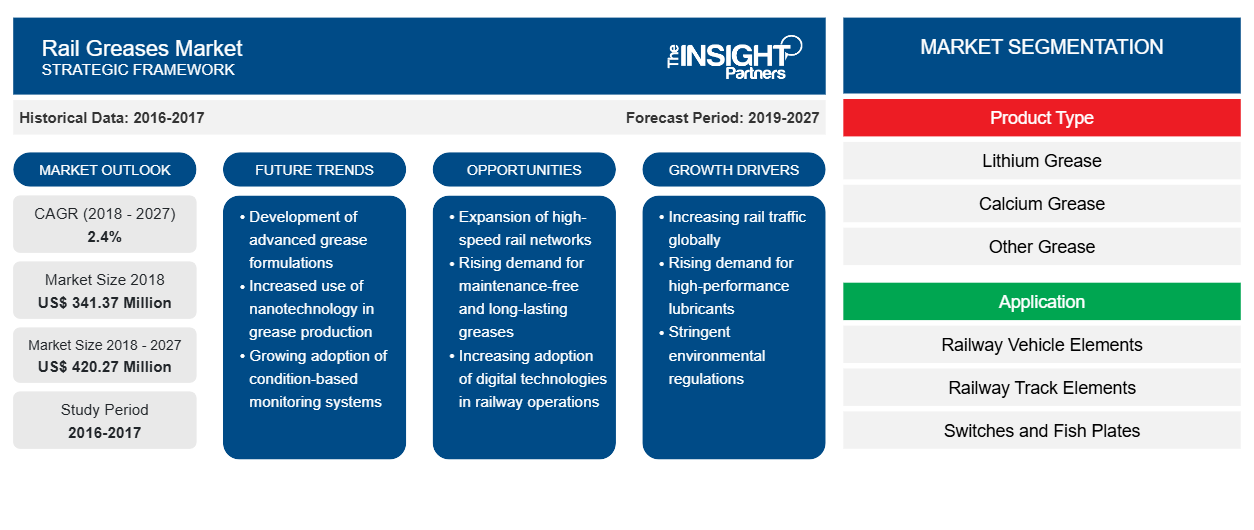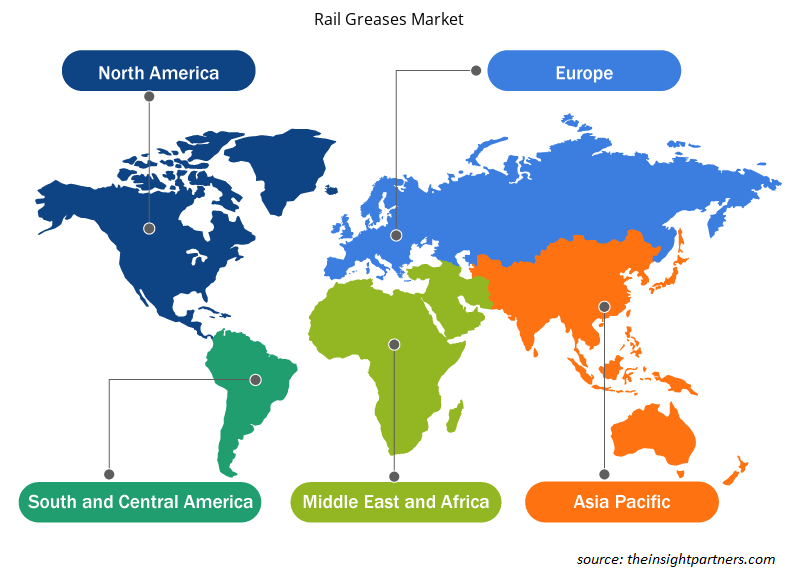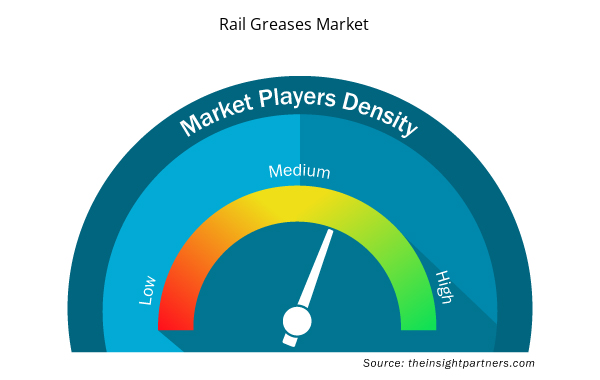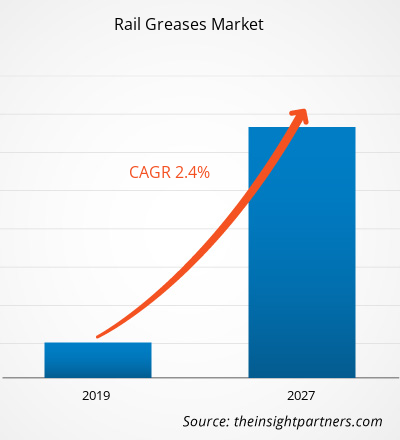The rail greases market was valued at US$ 341.37 million in 2018 and is projected to reach US$ 420.27 million by 2027; it is expected to grow at a CAGR of 2.4% from 2019 to 2027.
Grease is a solid or semi-solid lubricating oil. It usually comprises mineral oil and thickeners such as calcium-based soap and lithium-based soaps. Greases may also contain additional lubricating particles, such as molybdenum disulfide, graphite, or polytetrafluoroethylene (PTFE). Different types of greases combine the lubricating properties of oils with added stickiness, which allows the lubricant to adhere to the surfaces better. Grease possesses characteristic feature such as high initial viscosity, which make it frictional. It is popularly used across various industries such as automobile, railway, construction, pharmaceutical, food & beverage, and mining. For rails, greases can be used in mechanisms where lubrication is required frequently and where lubricating oil does not stay for long. Grease acts as a sealant to avert ingress of water and incompressible materials. Grease is also being used for maintenance of various rail elements such as railway axles & wheels, bearings & chains, brake elements, interior components, pantographs, and railway track components, as it prevents entry of contaminants or loss of lubricant.
In 2018, Asia Pacific has dominated the global rail greases market with highest market share and is estimated to be the fastest growing region during the forecast period. The growth of the rail greases market in this region is primarily due to booming economy, rapid urbanization, and growing investment by the government of emerging countries in the development of railway infrastructure. The countries across the region are experimenting with state-of-the-art transport technologies to make urban rail systems more efficient, reliable, and passenger friendly. The Asia Pacific metro systems are progressively moving from semi-automatic to driverless/unmanned train operations. Most of the upcoming systems are introducing the deployment of cutting-edge technological solutions for the comfort and safety of commuters. Hence, the rail greases market is expected to experience rapid growth in the region. Furthermore, numerous government initiatives for digitization in the region’s conventional railway networks will also drive the growth of the rail greases market during the forecast period.
Customize This Report To Suit Your Requirement
You will get customization on any report - free of charge - including parts of this report, or country-level analysis, Excel Data pack, as well as avail great offers and discounts for start-ups & universities
Rail Greases Market: Strategic Insights

- Get Top Key Market Trends of this report.This FREE sample will include data analysis, ranging from market trends to estimates and forecasts.
You will get customization on any report - free of charge - including parts of this report, or country-level analysis, Excel Data pack, as well as avail great offers and discounts for start-ups & universities
Rail Greases Market: Strategic Insights

- Get Top Key Market Trends of this report.This FREE sample will include data analysis, ranging from market trends to estimates and forecasts.
Impact of COVID-19 Pandemic on Rail Greases Market
The COVID-19 pandemic originated in Wuhan (China) in December 2019, and since then, it has spread across the globe at a fast pace. The US, Russia, India, Italy, China, Spain, France and Germany are among the worst-affected countries in terms confirmed cases and reported deaths as of July 2020. The pandemic has affected economies and industries due to enforced lockdowns, travel bans, and business shutdowns. After the spread of the COVID-19 outbreak, demand for rail greases has hampered across various regions due supply chain breaks, disruptions in manufacturing due to lockdown and office shutdowns as a result of this outbreak. The lockdown of various plants and factories in leading regions such as Asia Pacific and North America is affecting the manufacturing, delivery schedules, and sales of rail greases thus impacting the global rail grease market negatively.
Market Insights
Regular Maintenance Activities of Different Parts Used in Railway Transportation
Railway vehicle elements such as axles & wheels, bearings & chains, brake elements, interior components, and pantographs need frequent maintenance and lubrication for smooth running and high performance. Applying greases on wheels offer various benefits such as it reduces labor costs, extends repair intervals, and reduces lubricant consumption. Using greases for railway vehicle elements offers various operation benefits such as increases equipment reliability, reduces unplanned downtime, reduces energy and fuel consumption, and improves equipment profitability. Moreover, greases can help in saving energy and reducing noise. The axle box bearing of a vehicle-track system is an important component of a railway and train bogie, which bears a variety of complicated stochastic loads between the track and bogie. The reliability and service life of axle box bearings can influence railway safety. Grease plays a major part in the lubrication of railway axle box bearings as lubrication failures of axle box bearings can lead to accidents, such as hot axle cutting and bearing burnout. Additionally, greases are also used in other railway components such as track components, brakes, and interior components. Greases used in the railway track components are designed to minimize friction, reduce temperature, and prevent wear between wheel flange and rails. Greases are also used in screws and bolts used in the installation of railway track elements to protect them from rusting. Thus, the rail greases are mostly required for the maintenance activities and for smooth running and high performance of different parts such as railway vehicle components and railway track components. This fact has driven the market for rail greases during the forecast.
Type-Based Insights
Based on product type, the rail greases market is bifurcated into lithium grease, calcium grease, and other grease. In 2018, the lithium grease segment dominated the global rail greases and is expected to grow at fastest growth rate during the forecast period. Lithium grease is multi-purpose type grease with a buttery texture and dropping point above 350°F. Moreover, it can also be used with occasional temperatures up to 300°F. Lithium grease has excellent resistance to water and breakdown or softening. Lithium-based greases are the most commonly used in railway applications due to its higher melting point compared to others. Lithium greases are used in various parts in railways and trains such as curved tooth coupling, cardan shaft, axle boxes, and brake system due to their high pumpability. Regular maintenance activities of different parts used in railway transportation is expected to drive the demand for lithium grease during the forecast period.
Application-Based Insights
Based on application, the rail greases market is segmented into railway vehicle elements, railway track elements, switches and fish plates, curve rails, and screw and bolts. The railway vehicle elements segment dominated the global rail greases market; whereas, the curve rails segment is expected to grow at a fastest growth rate during the forecast period. Lubricators are used extensively on curved track to control excessive wear of wheels and rails. Grease and oils are typically applied to the gauge face of the outside (high) rail of curves, and in addition to reducing wheel and rail wear, it has been shown to reduce rail end batter and the rate of corrugation growth. Recent research has demonstrated that effective lubrication has the added benefit of reducing energy and fuel consumption, which is causing many railway engineers to pay increased attention to lubricating practices. This further boosts the demand for rail greases globally. Additionally, in curved sections, the high rail (outside curve) wheel runs on the gauge face. This results in semi continuous friction that significantly causes wear to gauge face and the wheel flange. The strong contact friction forces between wheel and rail contact surfaces cause noise emission in the track curve. Therefore, greases are used to reduce friction. Specifically, in city center areas where tight track curves are prevalent, lubrication systems offer the solution to reduce the notorious curve squealing. Greases are used to reduce wear and curve noise on gauge face and top-of-rail. Therefore, in order to improve the economic life of rails, the lubrication of the curve rails has been considered to be an easy and economical solution.
Distribution Channel-Based Insights
Based on distribution channel, the rail greases market is segmented into offline and online. The offline segment dominated the global rail greases market; whereas, the online segment is expected to grow at a faster growth rate during the forecast period. The increasing adoption of digital channels across the globe has brought about an increased emphasis on online distributions channels. Internet usage and smartphone ownership rates are growing across the world, and consumers are becoming more inclined to do everything from conducting research to make their final purchase decision online. Several benefits, such as convenience, fast delivery, and secure payment options, have attracted B2B buyers to purchase online. Thus, the companies operating in the rail grease market have optimized their distribution strategy over the past few years to keep pace with the competition and continue to grow their business. The companies are adopting online distribution channels to target and reach a large number of customers in the market, along with their traditional offline distribution channels. Additionally, online distribution channels help companies to reach the target consumers without adding additional costs and expenses. Thus, the manufacturers of lubricants and grease are leveraging e-commerce industry to earn revenue by opening online stores and making sales through these channels.
Royal Dutch Shell Plc (Shell), Exxon Mobil Corporation, Total SA., BP Australia Pty Limited, Petroliam Nasional Berhad (Petronas), SKF Group, FUCHS, Chevron Corporation, Klüber Lubrication and Sinopec Corp. are among the key players operating in global rail greases market. Companies in this market have been continuously focusing on strategies such as product developments, plant expansions, and mergers and acquisitions to expand their footprint worldwide and fulfill the growing demand of the market.
Rail Greases Market Regional Insights
The regional trends and factors influencing the Rail Greases Market throughout the forecast period have been thoroughly explained by the analysts at Insight Partners. This section also discusses Rail Greases Market segments and geography across North America, Europe, Asia Pacific, Middle East and Africa, and South and Central America.

- Get the Regional Specific Data for Rail Greases Market
Rail Greases Market Report Scope
| Report Attribute | Details |
|---|---|
| Market size in 2018 | US$ 341.37 Million |
| Market Size by 2027 | US$ 420.27 Million |
| Global CAGR (2018 - 2027) | 2.4% |
| Historical Data | 2016-2017 |
| Forecast period | 2019-2027 |
| Segments Covered |
By Product Type
|
| Regions and Countries Covered | North America
|
| Market leaders and key company profiles |
Rail Greases Market Players Density: Understanding Its Impact on Business Dynamics
The Rail Greases Market is growing rapidly, driven by increasing end-user demand due to factors such as evolving consumer preferences, technological advancements, and greater awareness of the product's benefits. As demand rises, businesses are expanding their offerings, innovating to meet consumer needs, and capitalizing on emerging trends, which further fuels market growth.
Market players density refers to the distribution of firms or companies operating within a particular market or industry. It indicates how many competitors (market players) are present in a given market space relative to its size or total market value.
Major Companies operating in the Rail Greases Market are:
- Royal Dutch Shell Plc (Shell)
- Exxon Mobil Corporation
- Total SA.
- BP Australia Pty Limited
- Petroliam Nasional Berhad (Petronas)
Disclaimer: The companies listed above are not ranked in any particular order.

- Get the Rail Greases Market top key players overview
Global Rail Greases Market – by Type
- Lithium Grease
- Calcium Grease
- Other Grease
Global Rail Greases Market – by Application
- Railway Vehicle Elements
- Railway Track Elements
- Switches and Fish Plates
- Curve Rails
- Screw and Bolts
Global Rail Greases Market – by Distribution Channel
- Offline
- Online
Company Profiles
- Royal Dutch Shell Plc (Shell)
- Exxon Mobil Corporation
- Total SA.
- BP Australia Pty Limited
- Petroliam Nasional Berhad (Petronas)
- SKF Group
- FUCHS
- Chevron Corporation
- Klüber Lubrication
- Sinopec Corp
- Historical Analysis (2 Years), Base Year, Forecast (7 Years) with CAGR
- PEST and SWOT Analysis
- Market Size Value / Volume - Global, Regional, Country
- Industry and Competitive Landscape
- Excel Dataset



Report Coverage
Revenue forecast, Company Analysis, Industry landscape, Growth factors, and Trends

Segment Covered
Product Type , Application ; Distribution Channel , and Geography

Regional Scope
North America, Europe, Asia Pacific, Middle East & Africa, South & Central America

Country Scope
Argentina, Australia, Brazil, Canada, China, France, Germany, India, Italy, Japan, Mexico, Russian Federation, Saudi Arabia, South Africa, South Korea, United Arab Emirates, United Kingdom, United States
Frequently Asked Questions
Based on product type, why is the lithium grease segment expected to grow at the highest rate during 2019–2027?
In 2018, the lithium grease segment accounted for the largest market share in the global rail greases market by product type. Lithium grease is multi-purpose type grease with a buttery texture and dropping point above 350°F. Moreover, it can also be used with occasional temperatures up to 300°F. Lithium grease has excellent resistance to water and breakdown or softening. Lithium-based greases are the most commonly used in railway applications due to its higher melting point as compared to others. Lithium greases are used in various parts in railways and trains such as curved tooth coupling, cardan shaft, axle boxes, and brake system due to their high pumpability. Regular maintenance activities of different parts used in railway transportation is expected to drive the demand for lithium grease during the forecast period.
Can you list some of the major players operating in the global rail greases market?
The major players operating in the global rail greases market are Royal Dutch Shell Plc, Exxon Mobil Corporation, Total SA, BP Australia Pty Limited, Petroliam Nasional Berhad (Petronas), FUCHS, SKF Group., Chevron Corporation, Klüber Lubrication, and Sinopec Corp among many others.
Which region held the largest share of the global rail greases market?
In 2018, the rail greases market was predominant in Asia-Pacific at the global level. The growth of the rail greases market in this region is primarily due to booming economy, rapid urbanization and growing investment by the government of emerging countries in the development of railway infrastructure. The countries across the region is experimenting with state-of-the-art transport technologies to make urban rail systems more efficient, reliable and passenger friendly. The Asia Pacific metro systems are progressively moving from semi-automatic to driverless/unmanned train operations. Most of the upcoming systems are introducing the deployment of cutting-edge technological solutions for the comfort and safety of commuters. Hence, the rail greases market is expected to experience rapid growth in the region.
Trends and growth analysis reports related to Chemicals and Materials : READ MORE..
The List of Companies - Pea Protein Market
- Royal Dutch Shell Plc (Shell)
- Exxon Mobil Corporation
- Total SA.
- BP Australia Pty Limited
- Petroliam Nasional Berhad (Petronas)
- SKF Group
- FUCHS
- Chevron Corporation
- Klüber Lubrication
- Sinopec Corp

 Get Free Sample For
Get Free Sample For